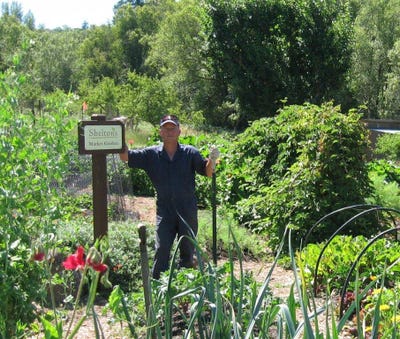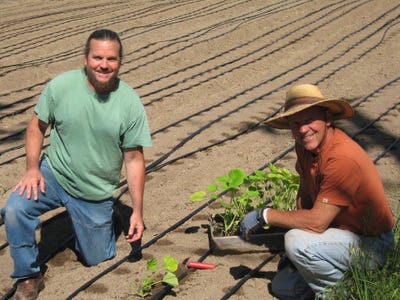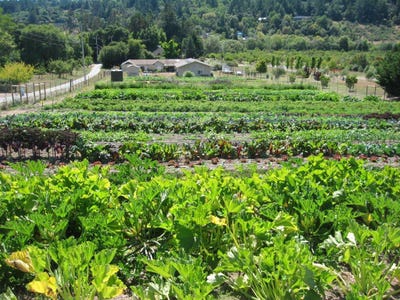
Local doesn’t get much more legit than farm to shelf. During high season, Shelton’s Natural Foods Market in Healdsburg, Calif., stocks about 15 percent of its produce department from its own Shelton’s Market Garden. Natural Foods Merchandiser caught up with Ernie and Marty Shelton for the scoop on living la vida local and the art of growing your own produce for retail.
Natural Foods Merchandiser: What’s the story behind Shelton’s Market Garden? Why did you start your organic garden?
Ernie Shelton: We bought our little store in 2008; and basically I started the garden project as an expression of my love of gardening and a vision I’ve always had of coupling a growing operation with a retail store. It offered us a unique opportunity to strengthen the store’s brand in the community.
NFM: How much produce do you provide for your store?
ES: It varies seasonally. In the height of the season, we bring in about 15 percent of what the produce department offers, but those are items unique to our microclimate. Our season basically runs April through December, with a small amount of year-round product.
NFM: What are the challenges of growing the produce for your market?
ES: The main challenges are finding the balance between producing a great variety and the complexity of farm management this concept entails. When growing for the store, our goal is to try to grow as much variety and have as much of our own produce on the stand as we can. But it makes the farming operation more difficult; it would be easier to grow more of fewer items, but then, of course, we’d overwhelm the store’s sell-through capacity. So that’s probably the biggest challenge, just finding a balance between variety and quantity.
N FM: What advice would you impart to other retailers for how to strike that balance?
FM: What advice would you impart to other retailers for how to strike that balance?
ES: Have a good business plan in place, and make sure that the produce manager and farmer are on the same page. Plan well and execute as best you can.
NFM: What general farm-to-shelf advice can you offer?
ES: Our efforts are to strengthen our relationship with our customers. We felt that we had an opportunity to do that through our own farming operation. Other stores may not have that unique opportunity and may not want to disrupt the ecosystem that they already have established with local producers or local farmers. Anybody else who might be looking to do something similar should certainly approach the opportunity like any other startup and be well capitalized, have a good plan in place, not have expectations for profitability that are unreasonable, and have the skill set on board to produce a great product. That’s the ultimate goal—to have a great, fresh, highly nutritious product on the stand that your customers can take home and eat and remember for how wonderfully flavorful and gorgeous the product is.
And if you can’t do that, then let somebody else do it.
Especially with fresh produce, it’s a tricky thing. How a grower takes care of product after it’s harvested can sometimes be as important as how he took care of it when it was in the ground. All the aspects of growing, transporting and taking good care of the product before it ever reaches the stand have to be considered.
NFM: In what other ways do you support local at Shelton’s Natural Foods Market?
ES: Productwise we live in a very rich agricultural environment, so our opportunity to support local—farmers, manufacturers, producers—is enhanced.
NFM: How do you define local?
Marty Shelton: We look at it in a three-tiered way. First of all, Sonoma County as much as possible in what’s offered, and then we look to second-tier, neighboring counties. Third tier would be northern California. NFM: With so many great local products in your area, how do you select the best for your store?
NFM: With so many great local products in your area, how do you select the best for your store?
ES: First and foremost, things need to taste good; they need to earn their place on the shelf from a quality perspective. From there, we prioritize regionally based products. Is the producer up and running and ready to supply us with product on a convenient and steady basis? Is he or she ready to extend in the marketplace and prepared with distribution?
Basically, we look at producers, especially if they’re new, and see if their house is in order and whether they’re ready to support the store as much as we’re ready to support them. That mutual support extends to co-marketing efforts. Getting people into the store to do demos is our main vehicle for introducing or promoting new product.
NFM: What are your best local sellers?
ES: We’re in a dairy-rich region, as well as, obviously, the vineyard and vegetable/fruits area. I think the dairy section in our particular marketplace has the biggest presence of local product.
NFM: What’s key when working with local vendors?
ES: You still use the same criteria with local product as you would with any product from a distributor or manufacturer—does the product taste good, does it look good on the shelf, does the labeling look sharp, is it going to draw people’s attention?
We, historically, through the course of our retail lives have always felt that our retail stores were a birthplace for new product. So we’ve always been very supportive, even when we had larger stores, to give new, local and most certainly organic products an opportunity to get birthed into the marketplace.
Historically, that’s what the natural foods industry provided for new manufacturers. That, of course, has changed over the years as our industry has gotten larger and the cost of product development and introduction has skyrocketed. But as a small store, we still have that unique opportunity to help birth a small regional manufacturer because we’re properly scaled to the opportunity. So somebody who doesn’t have half a million dollars to launch into a major market play can still find some traction regionally in our store and in other small chains that might support a regional producer to test the waters, perfect its product and get some traction. It’s sort of the old-story way that people used to get into the marketplace, which is rarer these days because the cost of entry is so high. NFM: We’ve heard that local trumps organic more and more these days. What’s your take, and what do your customers prefer?
NFM: We’ve heard that local trumps organic more and more these days. What’s your take, and what do your customers prefer?
MS: I believe our customer base, at this time, prefers organic to local. I think we cater more to an organic crowd, actually.
ES: Some of that is our own self-definition, it’s our preference, and certainly customers in our region can find plenty of organic product that’s produced locally. So it’s not necessarily an either/or situation in our region. It’s probably somewhere in the middle.
For a local producer to have customer support, if they’re not organic in our store, they need to have a reputation that precedes them. A few people do; some people don’t. If the producer has a strong farmers market presence and people see its products in our store, then they might know the farmer’s story firsthand. It’s one of the advantages of a farmer or producer direct marketing its product—having the opportunity to talk one-on-one with customers. When selling product through a third party, the label has to do the talking. And one of the ways that the label speaks the loudest is by having the third-party organic certification. That communicates pretty strongly to the customer.
NFM: What are your future farm plans?
ES: For 2013, we’re planning on just doing a better job with what we have. We have three acres of farmland that we’re working with now, and our goal here is to optimize, optimize and optimize and then grow from there. We love doing it. The idea is being well received in the community. And for the store, and we’ll continue to grow the idea and get better and better.
About the Author
You May Also Like
.png?width=700&auto=webp&quality=80&disable=upscale)



